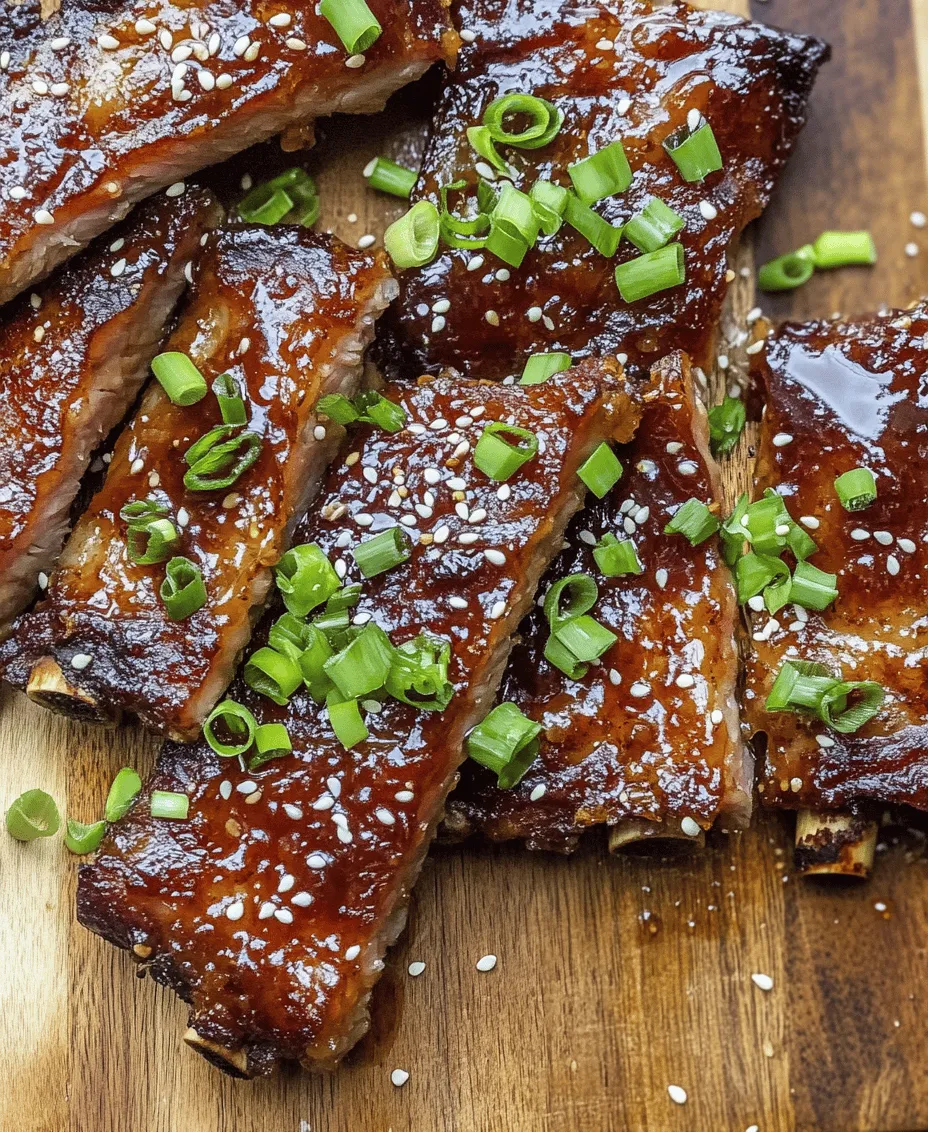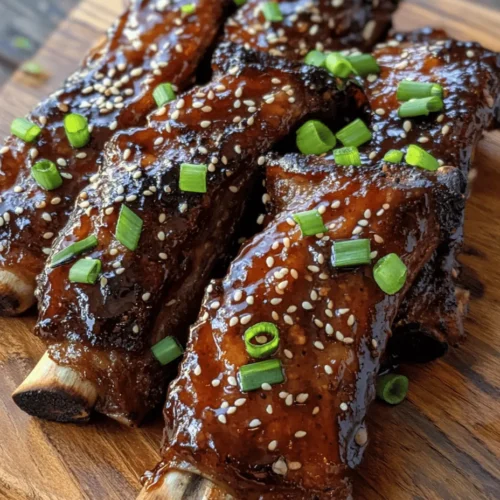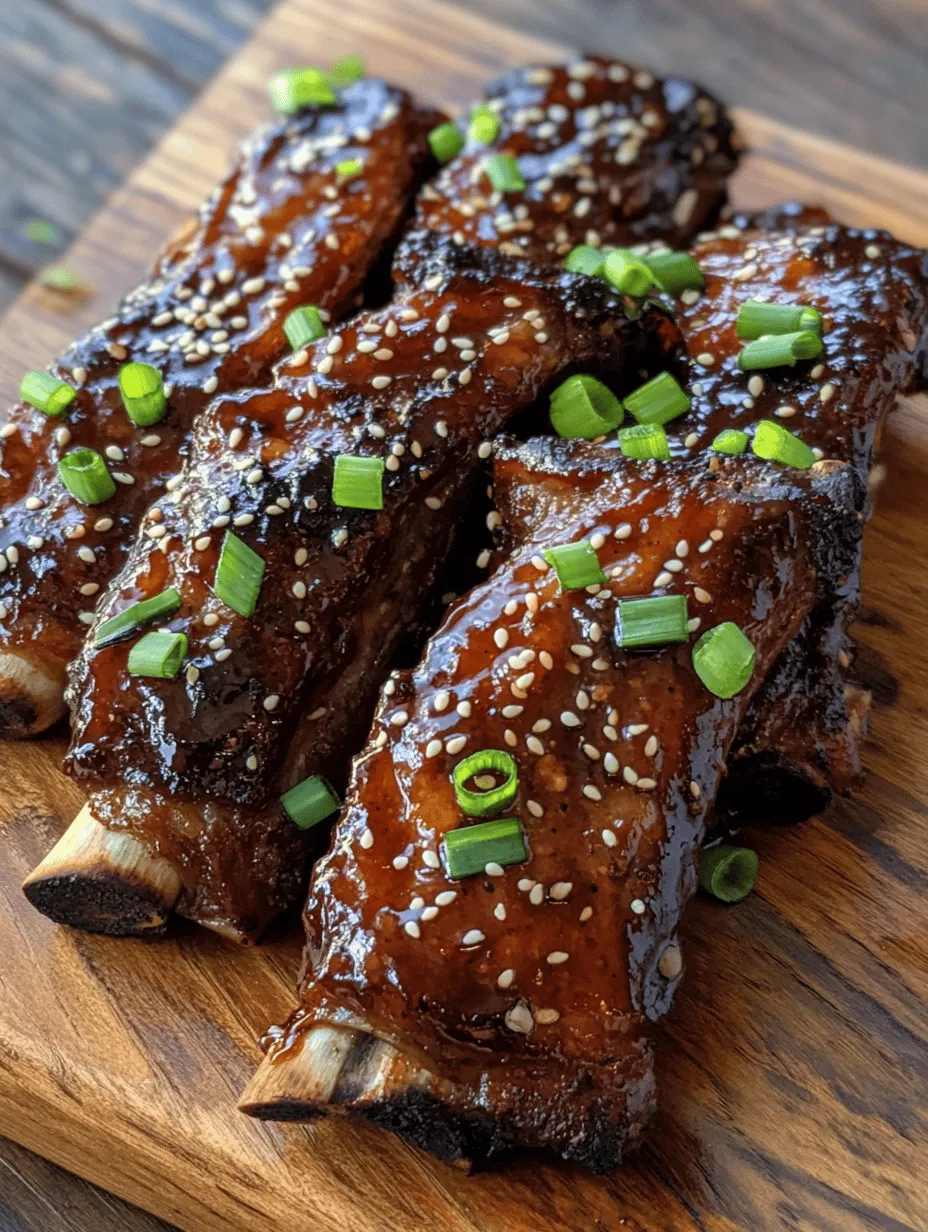Introduction
Asian cuisine is beloved worldwide, celebrated for its vibrant flavors, diverse ingredients, and rich culinary traditions. From the fragrant spices of Indian curries to the bold and savory dishes of Chinese stir-fries, each region offers a unique taste experience that tantalizes the palate. Among the many treasures of Asian cooking, one dish stands out for its irresistible combination of sweetness, savoriness, and tender texture: Asian Pork Ribs. These succulent ribs are not only a feast for the senses but also a fantastic centerpiece for family gatherings and special occasions.
The allure of Asian Pork Ribs lies in their sweet and savory profile, often enhanced by a blend of sauces and spices that create a symphony of flavors. Whether you’re hosting a festive dinner party or enjoying a cozy family meal, these ribs are sure to impress your guests and leave them craving more. What’s more, baking these ribs in the oven offers a delightful alternative to grilling, ensuring that they come out tender, juicy, and infused with flavor without the fuss of outdoor cooking.
In this article, we will guide you through the process of creating mouthwatering Asian Pork Ribs in the oven, revealing the secrets to achieving perfect results every time. We’ll explore the different types of pork ribs, the key ingredients that contribute to the dish’s distinctive taste, and the essential steps for preparing and cooking the ribs to perfection.
Understanding Pork Ribs
Before diving into the recipe, it’s essential to understand the different types of pork ribs available and their characteristics. The two most common types of pork ribs are baby back ribs and spare ribs, each offering a unique taste and texture.
Baby Back Ribs vs. Spare Ribs
Baby Back Ribs: These ribs are cut from the top of the rib cage, near the spine. They are shorter, curved, and leaner than spare ribs. Baby back ribs are known for their tender meat and are often favored for their mild flavor, making them an excellent choice for those who prefer a lighter taste.
Spare Ribs: Spare ribs are larger and flatter than baby back ribs, cut from the lower portion of the rib cage. They contain more fat and connective tissue, which makes them richer in flavor. The extra fat renders during cooking, resulting in juicy, flavorful meat. Spare ribs are often considered the more robust option for those who enjoy a heartier rib experience.
Nutritional Benefits of Pork Ribs
Pork ribs, while indulgent, can be a part of a balanced diet when enjoyed in moderation. They are an excellent source of protein, essential for muscle growth and repair, and contain important vitamins and minerals such as B vitamins (B6 and B12), zinc, and selenium. The protein content in pork ribs can help keep you full and satisfied, making them a great choice for gatherings where everyone can enjoy a hearty meal.
Tips for Selecting Quality Pork Ribs
When shopping for pork ribs, selecting high-quality meat is crucial for the best flavor and tenderness. Here are some tips for choosing the perfect ribs:
1. Look for Freshness: Choose ribs that have a bright pink or red color. Avoid any that appear gray or discolored, as this can indicate age.
2. Check for Marbling: Good marbling (the intramuscular fat) is key to flavor and tenderness. Look for ribs with a decent amount of fat while avoiding excess fat that could lead to greasiness.
3. Consider the Bone Type: If you’re unsure which type of ribs to choose, consider your cooking method and personal preference. Baby back ribs are ideal for those seeking tenderness, while spare ribs work well for a richer flavor experience.
4. Ask Your Butcher: If you have a trusted butcher, don’t hesitate to ask for recommendations. They can help you find the best cut and provide tips on preparation.
Key Ingredients and Their Roles
Now that we’ve covered the basics of pork ribs, let’s delve into the key ingredients that will elevate your Asian Pork Ribs to a culinary masterpiece. Each component plays a vital role in creating the quintessential balance of flavors that defines this dish.
Soy Sauce: Flavor Enhancer and Umami Source
Soy sauce is a staple in Asian cooking, imparting a deep, savory flavor known as umami. It not only enhances the overall taste of the ribs but also contributes to the beautiful caramelization that occurs during cooking. Opt for low-sodium soy sauce if you prefer a lighter saltiness without compromising flavor.
Hoisin Sauce: Sweetness and Depth
Hoisin sauce adds a rich sweetness and complexity to the dish. Made from fermented soybeans, sugar, and various spices, it is often described as a Chinese barbecue sauce. Its thick consistency allows it to cling to the meat, creating a delicious glaze that caramelizes beautifully in the oven.
Honey: Natural Sweetener and Caramelization Agent
Honey is another essential ingredient that enhances the sweetness of the ribs while promoting caramelization during the cooking process. Its natural sugars help create a glossy finish and a delightful contrast to the savory elements of the dish. For a richer flavor, consider using raw or local honey.
Rice Vinegar: Acidity and Balance
A splash of rice vinegar introduces acidity, which is crucial for balancing the rich flavors of the ribs. It cuts through the sweetness and enhances the overall taste profile. Look for unseasoned rice vinegar for the best results.
Sesame Oil: Nutty Flavor Contribution
Sesame oil is often used in Asian cuisine for its distinctive nutty flavor. A few drops in the marinade can impart a subtle depth that elevates the dish. It’s important to use toasted sesame oil for a stronger flavor, while regular sesame oil can be used for a milder taste.
Garlic and Ginger: Aromatic Elements
Fresh garlic and ginger are essential for adding aromatic elements to the ribs. Their pungent and spicy characteristics provide a robust foundation for the marinade, enhancing the overall flavor profile. Minced or grated, these ingredients should be used generously to create a fragrant base.
Five-Spice Powder: Unique Spice Blend
Five-spice powder is a quintessential seasoning in Chinese cuisine, combining star anise, cloves, Chinese cinnamon, Sichuan pepper, and fennel seeds. Its complex flavor adds warmth and depth to the dish, making it an indispensable ingredient for Asian Pork Ribs.
Black Pepper and Red Pepper Flakes: Adding Heat and Complexity
For those who enjoy a bit of heat, black pepper and red pepper flakes can be incorporated into the marinade. These spices not only add warmth but also enhance the complexity of flavors, balancing the sweetness with a subtle kick.
Importance of Using Fresh Ingredients
To achieve the best flavor in your Asian Pork Ribs, it is crucial to use fresh ingredients. Fresh garlic and ginger will provide a more intense aroma, while high-quality sauces will enhance the overall taste. Whenever possible, opt for organic or locally sourced ingredients to ensure the highest quality and flavor in your dish.
Preparing the Ribs
Now that we have gathered our ingredients and understood their roles, it’s time to prepare the ribs for cooking. Proper preparation is key to ensuring that your ribs absorb all the flavorful marinades and turn out tender and juicy.
Step 1: Remove the Membrane
One of the most important steps in preparing pork ribs is to remove the membrane from the back of the ribs. This thin layer can prevent marinades from penetrating the meat and can result in a chewy texture. Here’s how to do it:
1. Locate the Membrane: Flip the ribs over so that the bony side is facing up. You’ll see a thin, shiny membrane covering the back of the ribs.
2. Start at One End: Using a blunt knife, gently slide it under the membrane at one end of the ribs to create a small lift.
3. Grip the Membrane: Once you have lifted a portion of the membrane, you can use a paper towel for a better grip. This will help you pull it away without tearing.
4. Pull it Off: Carefully pull the membrane off the ribs, working your way down. If it tears, simply start again from another end.
5. Trim Excess Fat: After removing the membrane, take a moment to trim any excess fat from the ribs. While some fat is essential for flavor, too much can lead to greasiness.
By removing the membrane, you’ll ensure that your Asian Pork Ribs are packed with flavor and have a tender, enjoyable texture.
As we move forward, we will dive deeper into the marinating process and the cooking techniques that will transform these prepared ribs into a mouthwatering dish that captures the essence of Asian cuisine. Stay tuned for the next part, where we will cover the marinating process and the oven-baking technique to achieve perfect results.

Techniques for Patting Ribs Dry and Ensuring Even Marinade Coverage
Before diving into the marinade preparation for your Asian Pork Ribs, it’s essential to start with a clean slate. Patting the ribs dry is a crucial step that many home cooks might overlook. This process is not just about cleanliness; it plays a pivotal role in how well the marinade adheres to the meat.
1. Patting Dry: Use paper towels to thoroughly pat the ribs dry. This removes excess moisture that can hinder the marinade from penetrating the meat. By ensuring the ribs are dry, you will also help achieve a better sear during the cooking process.
2. Even Marinade Coverage: Once dry, it’s time to apply the marinade. To ensure even coverage, consider using a zip-top bag for marinating. This method allows the marinade to envelop the ribs completely. Simply place the ribs in the bag, pour in your marinade, seal it, and massage the bag gently to distribute the marinade evenly. If using a bowl, turn the ribs several times to coat them thoroughly.
Crafting the Perfect Marinade
Creating a delectable marinade is where the magic begins. The balance of flavors is crucial for the Asian Pork Ribs, as it sets the stage for a dish rich in taste.
In-Depth Look at the Marinade Preparation
The marinade typically consists of soy sauce, hoisin sauce, garlic, ginger, sesame oil, and a hint of chili for heat. Here’s how to prepare it:
1. Combine Ingredients: In a bowl, whisk together 1/2 cup soy sauce, 1/4 cup hoisin sauce, 2 tablespoons sesame oil, 4 cloves minced garlic, 1 tablespoon freshly grated ginger, and 1-2 teaspoons of chili paste or flakes, depending on your spice preference.
2. Sweetness and Acidity: To balance the savory elements, you might consider adding 2 tablespoons of brown sugar or honey to introduce sweetness. You could also add a splash of rice vinegar for acidity, which enhances the overall flavor profile.
3. Marination Time: Aim to marinate the ribs for at least 4 hours, but if time allows, overnight is ideal. This duration ensures that the flavors penetrate deeply into the meat, resulting in a more flavorful dish.
Suggested Variations
Feel free to tweak the marinade to suit your taste. For a more citrusy flavor, add the juice and zest of one orange or lime. If you prefer a smokier taste, a few drops of liquid smoke can elevate the depth of flavor. Experimenting with ingredients like sriracha, honey, or even pineapple juice can yield delightful results.
The Baking Process
Once your ribs have marinated to perfection, it’s time to move on to the baking process. This method is simple yet effective in delivering tender, flavorful ribs.
Preheating the Oven and Preparing Baking Sheets
1. Preheat: Start by preheating your oven to 300°F (150°C). This low and slow cooking method is essential for achieving tender ribs.
2. Prepare Baking Sheets: Line a baking sheet with aluminum foil for easy cleanup. You may also want to place a wire rack on top of the baking sheet. This setup allows for even cooking and prevents excess moisture from accumulating.
Covering the Ribs with Foil
Once your ribs are ready to go, place them on the wire rack and cover them tightly with another piece of aluminum foil. This step is crucial in the initial phase of baking, as it traps steam and moisture, ensuring the ribs cook evenly and remain juicy.
Timing and Temperature Guidelines
Cook the ribs covered for about 2 to 2.5 hours, depending on their size. The low temperature allows the collagen in the meat to break down, resulting in tender, fall-off-the-bone goodness. After this time, check for tenderness by inserting a fork into the meat; it should slide in easily.
Glazing for Perfection
The final steps of the cooking process are all about achieving that signature sticky glaze that makes Asian Pork Ribs so irresistible.
Removing the Foil for the Last Bake
After your ribs have cooked for the designated time, carefully remove the foil. Be cautious of the steam that may escape. At this point, you want to crank up the oven temperature to 400°F (200°C).
Techniques for Basting and Ensuring Even Caramelization
1. Baste: Brush the ribs generously with the remaining marinade or a homemade glaze (made from the marinade mixed with a bit of cornstarch for thickness) every 10-15 minutes during the final 30 minutes of baking. This technique not only enhances the flavor but also helps create a beautiful caramelization on the surface.
2. Recognizing Doneness: You’ll know the ribs are ready when they are beautifully glazed and have a rich, deep color. The meat should also start pulling away slightly from the bones, indicating they are perfectly tender.
Serving Suggestions
When it comes to serving your Asian Pork Ribs, consider pairing them with sides that complement their rich flavors.
Recommendations for Side Dishes
1. Rice: Steamed jasmine or basmati rice works wonderfully, as it soaks up the excess sauce beautifully. For a twist, try coconut rice or fried rice.
2. Vegetables: Sautéed bok choy, garlic green beans, or stir-fried broccoli add a crisp texture and vibrant green color to your plate. Toss the vegetables in a splash of soy sauce or sesame oil for extra flavor.
3. Salads: A refreshing cucumber salad or an Asian slaw with sesame dressing can provide a nice contrast to the ribs’ richness. The crunch and acidity will balance the dish perfectly.
Ideas for Garnishing and Presentation
To elevate the visual appeal of your dish, consider garnishing the ribs with sesame seeds and chopped green onions. A sprinkle of fresh cilantro can add a burst of color and flavor. For an attractive presentation, arrange the ribs on a large platter, surrounding them with your chosen sides, creating a feast for the eyes as well as the palate.
Conclusion
In conclusion, Asian Pork Ribs are a delightful dish that brings together a harmonious blend of flavors and textures. The careful preparation of the marinade, the slow-baking method, and the final glazing technique all come together to create a truly memorable meal. This recipe’s versatility allows you to customize it to your liking, whether through variations in the marinade or creative side dishes.
Cooking is not just about nourishment; it’s about sharing joy and creating lasting memories with loved ones. So, roll up your sleeves, gather your ingredients, and embark on this culinary adventure. Once you experience the satisfaction of creating these flavorful Asian Pork Ribs, you’ll find yourself returning to this recipe time and time again. Enjoy the process and happy cooking!


